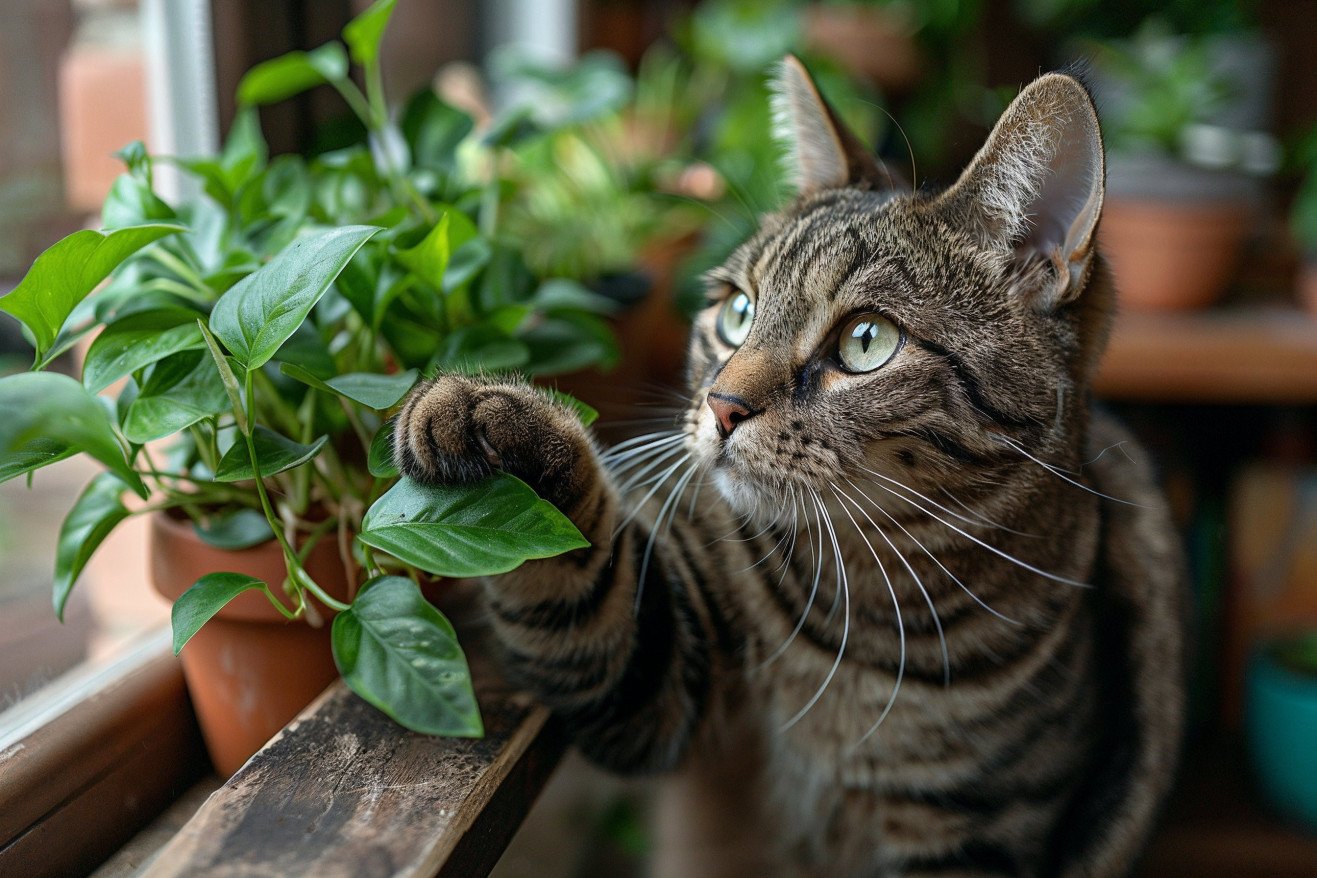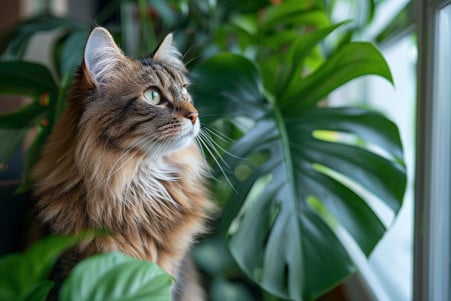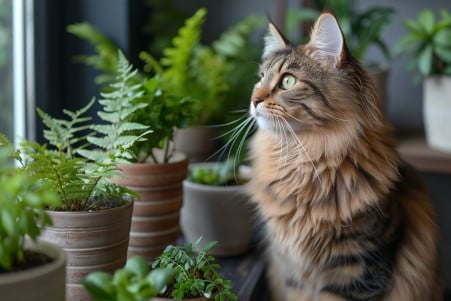Is Pothos Toxic to Cats? Understanding the Risks and Responses
17 February 2024 • Updated 16 February 2024

Having plants in your home can make a huge difference in your space, but are you putting your cat in danger with your decor? Yes, pothos (Epipremnum aureum) is toxic to cats. When cats eat the plant, the insoluble calcium oxalate crystals in pothos can cause oral irritation, difficulty swallowing, and vomiting. If your cat eats pothos, it’s important to get them to the vet right away to make sure they’re OK.
This article will use information from veterinary science and toxicology studies to provide a comprehensive look at the risks associated with cats and pothos plants. It will cover the plant’s chemical properties that make it toxic, the symptoms of exposure, and the short- and long-term effects of poisoning.
It will also offer information on non-toxic plants you can keep in your home and the emergency care your cat will receive if they’re poisoned by pothos, so you can make sure your home is safe for your pet.
Is pothos toxic to cats?
Understanding the Risks of Pothos Poisoning in Cats
The key to understanding pothos toxicity is the plant’s biochemical defense mechanism: calcium oxalate crystals. Catster explains that these tiny, needle-shaped raphides are found in the plant’s cells and are a natural defense against herbivores. When cats eat pothos leaves or stems, the raphides are released and pierce the soft tissues of the mouth and gastrointestinal tract, leading to irritation.
This irritation causes an immediate and uncomfortable reaction in cats, says Davin Eberhardt. The body goes into overdrive to protect itself, leading to symptoms like drooling, pawing at the mouth, and vomiting, as the cat tries to get rid of the raphides.
Over time, members of the Arum family have developed raphides as a way to protect themselves from herbivores, a characteristic that is common among the family, according to Biology Stack Exchange. While the crystals are effective at protecting the plant, they also make it dangerous to pets. Understanding the presence and impact of these toxic crystals highlights the importance of cat owners’ diligence in preventing accidental exposure and keeping their pets safe.
How to Tell If Your Cat Has Eaten Pothos
If a cat has eaten pothos, the signs are hard to miss. According to PetMD, symptoms of pothos poisoning in cats include excessive drooling, severe mouth irritation, and vomiting.
Because these symptoms are so severe, it’s important to know how to respond to them. If you suspect that your cat has eaten pothos, it’s important to act quickly to minimize the damage. First, remove any plant material from your cat’s mouth. Then, place your cat in a secure area where they can’t eat any more of the plant.
According to Olympia Pet Emergency, you should also contact your vet to let them know what happened. This will help them diagnose and treat your cat more effectively. If you can, let your vet know that your cat ate pothos. This will help them know what to look for.
If you’re not sure whether or not your cat ate pothos, you can also bring a sample of the plant or a detailed description of it to your vet.
To protect your cat from pothos poisoning, it’s important to make sure that all of the plants in your home and garden are non-toxic and out of your cat’s reach. According to International Cat Care, you can do this by learning about pet-safe plants and securing dangerous plants.
This way, you can make sure that your cat is safe and healthy. By being aware and prepared, you can make sure that you’re ready to deal with any incidents of pothos poisoning and that your cat and plants can coexist peacefully.
Long-Term Risks of Pothos Toxicity in Cats
While most cats will overcome the immediate effects of pothos toxicity with the help of a vet, there are some concerns about long-term health effects. Cats can develop chronic issues due to repeated exposure to the calcium oxalate crystals in pothos. In fact, these crystals are known to be involved in the formation of calcium oxalate bladder stones, which are a painful and serious health issue for cats.
As the vet-authored manual points out, it’s not just the immediate symptoms, including drooling, vomiting, and difficulty swallowing, that can be problematic. The aftermath of pothos poisoning can also lead to a cat having a sensitive stomach, which may require a special diet or soft, bland foods to help the cat recover.
In addition, cats can be at risk for severe dehydration after recovering from pothos toxicity, which can be life-threatening, so it’s important to make sure the cat has fully and completely recovered.
While the details of a sensitive stomach or ongoing issues after an initial exposure to pothos aren’t well-documented, the potential for chronic exposure to lead to complications is clear. It’s important to make sure that cats can’t get to pothos plants after they’ve recovered to prevent them from being re-exposed and to prevent them from suffering long-term consequences.
Doing so can help ensure that they make a full recovery and that they’re safe and healthy in their home.
How to Create a Cat-Safe Garden Indoors
With the desire to bring the outdoors in and make their homes more beautiful, cat owners can turn to a variety of non-toxic, cat-friendly houseplants. Some options that are both beautiful and safe for pets include the Pineapple plant, Ananas comosus, and the Cast iron plant, Aspidistra elatior, according to BBC Gardeners’ World Magazine.
The Boston fern is another great option, especially since it’s been shown to be one of the best air-purifying plants by NASA.
For those who want to create a tropical paradise in their home, the humidity-loving Calathea orbifolia, which has decorative leaves that close at night, is a great choice. Meanwhile, The Spruce recommends the Spider plant, Chlorophytum comosum, for its low maintenance and air-purifying properties.
Of course, it’s important to make sure that the plants you choose will be safe for your cat. By choosing from a variety of non-toxic plants, cat owners can help ensure that their cats won’t be accidentally poisoned.
This is an important part of being a responsible pet owner and will help make sure that your home is a safe place for everyone who lives in it. This way, you can enjoy the benefits of having plants in your home without the dangers of toxic plants like pothos.
What to Do If Your Cat Is Poisoned by Pothos
If you suspect your cat has been poisoned by pothos, it is important to act quickly. According to PetMD, you should start by gently removing any plant material from your cat’s mouth to prevent further ingestion. After that, you should place your pet in a secure location and monitor them for any signs of distress.
The Pet Poison Helpline advises against trying to make your cat vomit or giving them any at-home remedies, like milk, which can make symptoms worse in lactose-intolerant animals and does not act as an antidote to poison.
Since professional veterinary treatment is the only way to effectively treat pothos poisoning, it is important to seek help as soon as possible. Let the vet know that your cat has been exposed to pothos so that they can provide the most appropriate treatment. This may include giving the cat activated charcoal to absorb the toxins, intravenous fluids, and supportive care, such as anti-nausea or pain medications.
Getting your cat to the vet as soon as possible can greatly improve their chances of recovering from pothos poisoning. The Pet Poison Helpline notes that it is important to seek professional help and not try to treat your pet at home, which can make the situation worse. Taking your cat to the vet immediately and following their instructions will give your cat the best chance of recovering from pothos poisoning.
Protecting Your Feline Friends: A Recap of Pothos Plant Toxicity
Pothos, known for its heart-shaped leaves, is a highly toxic plant to cats due to the oxalate crystals it contains. If cats consume these crystals, they can suffer from oral irritation, vomiting, and other symptoms, all of which require veterinary care. While the short-term effects of pothos poisoning have been discussed, the less frequent long-term effects demonstrate the need for vigilance and understanding.
In order to keep your home safe for your pets, we recommend that cat parents choose non-toxic plants to fill their homes. This will allow you to have the best of both worlds, enjoying the beauty of indoor plants while avoiding the risks associated with toxic plants like pothos. The emergency treatment for pothos poisoning emphasizes the need for professional help and cautions against home treatments that can make the situation worse.
Being a good pet parent means more than just loving and caring for your animals, it also means keeping them safe. We can show that we are good pet parents by learning about the dangers of certain plants, learning to recognize the signs of poisoning, and knowing how to respond. Let’s make sure we are providing our feline friends with an environment that is as safe as it is loving.


